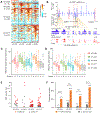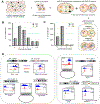Oncogenic extrachromosomal DNA functions as mobile enhancers to globally amplify chromosomal transcription
- PMID: 33836152
- PMCID: PMC8119378
- DOI: 10.1016/j.ccell.2021.03.006
Oncogenic extrachromosomal DNA functions as mobile enhancers to globally amplify chromosomal transcription
Abstract
Extrachromosomal, circular DNA (ecDNA) is emerging as a prevalent yet less characterized oncogenic alteration in cancer genomes. We leverage ChIA-PET and ChIA-Drop chromatin interaction assays to characterize genome-wide ecDNA-mediated chromatin contacts that impact transcriptional programs in cancers. ecDNAs in glioblastoma patient-derived neurosphere and prostate cancer cell cultures are marked by widespread intra-ecDNA and genome-wide chromosomal interactions. ecDNA-chromatin contact foci are characterized by broad and high-level H3K27ac signals converging predominantly on chromosomal genes of increased expression levels. Prostate cancer cells harboring synthetic ecDNA circles composed of characterized enhancers result in the genome-wide activation of chromosomal gene transcription. Deciphering the chromosomal targets of ecDNAs at single-molecule resolution reveals an association with actively expressed oncogenes spatially clustered within ecDNA-directed interaction networks. Our results suggest that ecDNA can function as mobile transcriptional enhancers to promote tumor progression and manifest a potential synthetic aneuploidy mechanism of transcription control in cancer.
Keywords: ChIA-Drop; ChIA-PET; chromatin interactions; ecDNA; mobile enhancers.
Copyright © 2021 Elsevier Inc. All rights reserved.
Conflict of interest statement
Declaration of interests R.G.W.V. is a co-founder of Boundless Bio, Inc (BB), and a member of its scientific advisory board. BB was not involved in the research presented here. C.-L.W., C.-H.W., H.T., and R.G.W.V. are co-inventors on a patent application (WO2020223309A1 "Extrachromosomal DNA identification and methods of use") submitted by The Jackson Laboratory. The other authors declare no competing interests.
Figures







Comment in
-
ecDNA party bus: Bringing the enhancer to you.Mol Cell. 2021 May 6;81(9):1866-1867. doi: 10.1016/j.molcel.2021.04.017. Mol Cell. 2021. PMID: 33961776
References
-
- Alt FW, Kellems RE, Bertino JR, and Schimke RT (1978). Selective multiplication of dihydrofolate reductase genes in methotrexate-resistant variants of cultured murine cells. J Biol Chem 253, 1357–1370. - PubMed
-
- Cox D, Yuncken C, and Spriggs AI (1965). Minute Chromatin Bodies in Malignant Tumours of Childhood. Lancet 1, 55–58. - PubMed
Publication types
MeSH terms
Substances
Grants and funding
LinkOut - more resources
Full Text Sources
Other Literature Sources
Molecular Biology Databases

